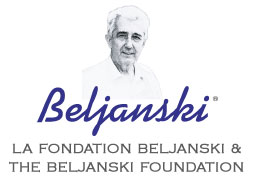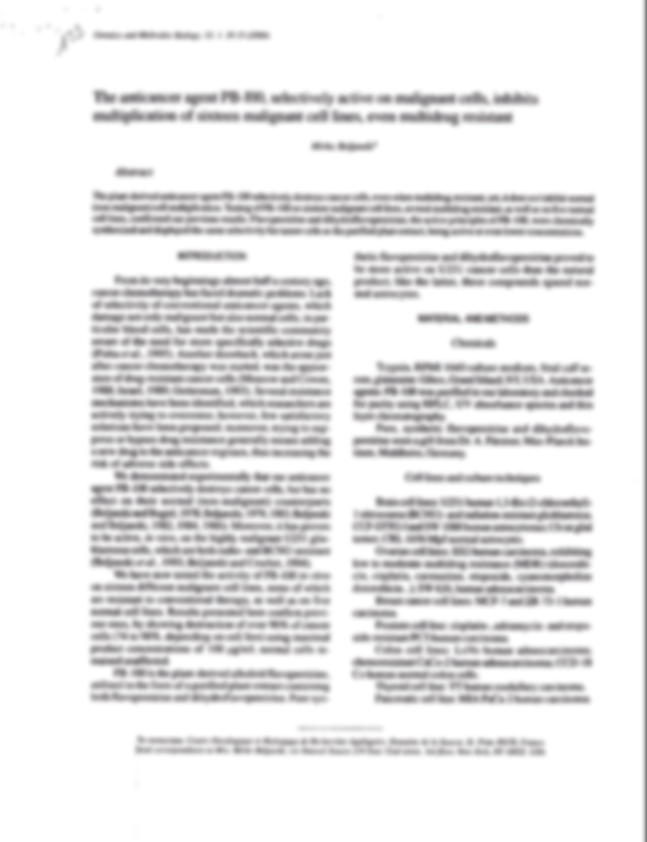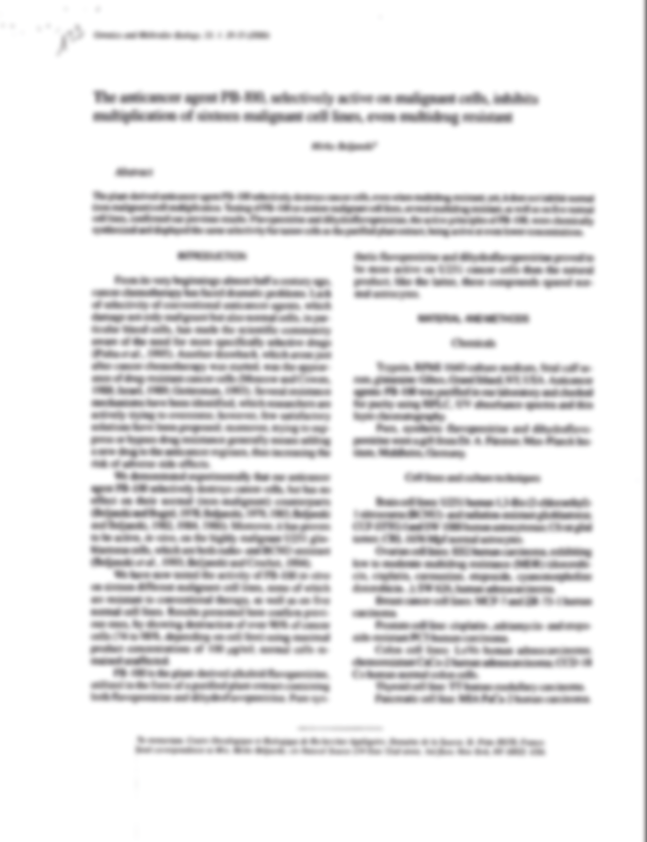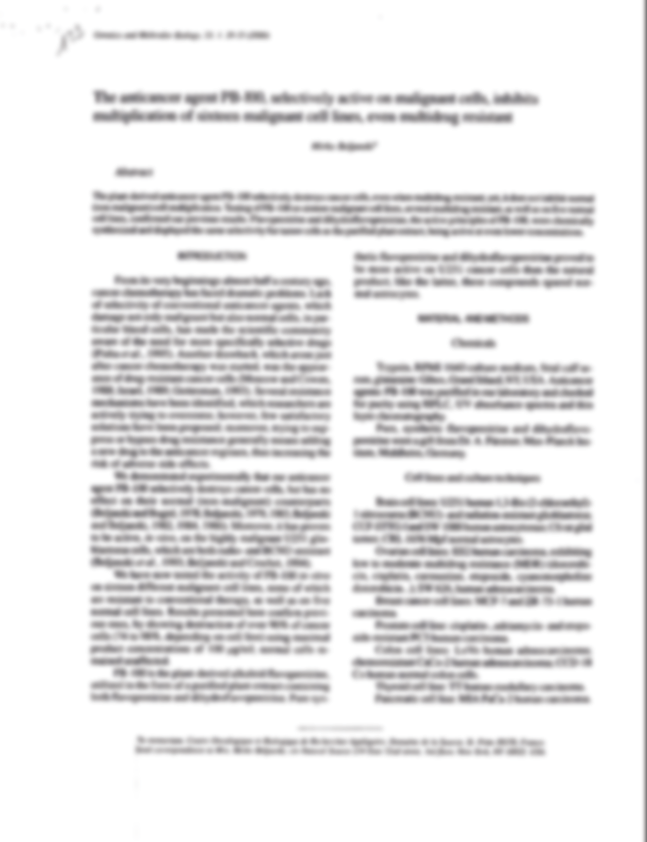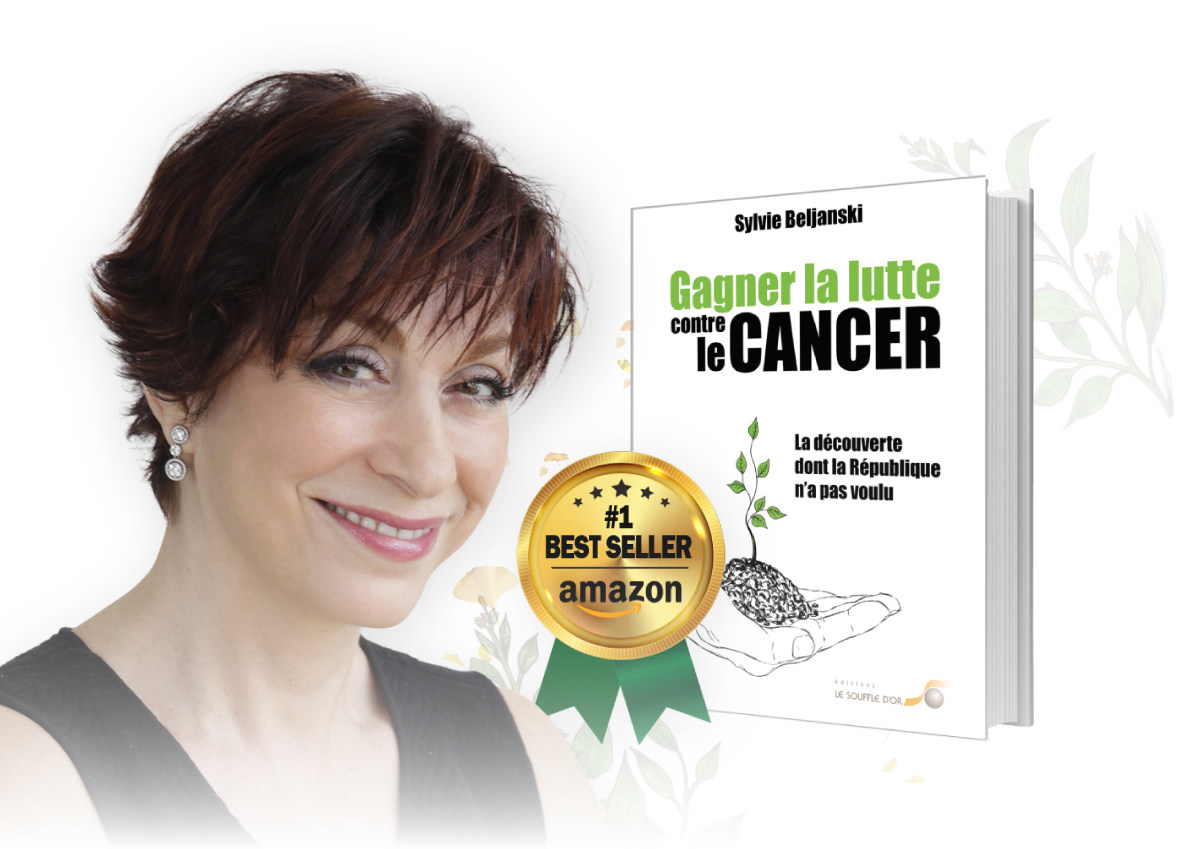90 – Differential susceptibility of cancer and normal DNA templates allows the detection of carcinogens and anticancer drugs
European Organization for Research on Treatment of Cancer
Third NCI-EORTC Sympmposium on new drugs in Cancer therapy, Institut Bordet, Bruxelles, 1981.
Available in English only
ABSTRACT: Based on the differential template activity exhibited by DNA isolated from cancerous and healthy human or animal tissues, the Oncotest is an accurate and rapid assay for the screening of carcinogenic compounds. Thus, in the presence of all necessary components for radioactive DNA synthesis by DNA polymerase, carcinogenic compounds, antimitotic drugs (and miscellaneous compounds), at given concentrations strongly stimulate the synthesis of DNA isolated from different cancer tissues, but only slightly enhance that of DNA from healthy tissues. Those carcinogens which cannot be characterized as mutagens in the Salmonella assay system, behave as carcinogens in the Oncotest. Carcinogenic potential of steroids can be shown by using the DNA from steroid hormone target tissue. There exists a common molecular mechanism through which carcinogens stimulate cancer DNA in vitro synthesis. Cancer DNAs are destabilized and in the presence of carcinogenic substances there is further DNA strand separation which accounts for the enhanced DNA synthesis. A correlation between in vitro cancer DNA synthesis, DNA strand separation and in vivo multiplication of cancerous cells can be demonstrated. Our assay system allows to detect those substances which selectively inhibit cancer DNA synthesis without affecting, in an appreciably way, that of DNA from healthy tissues.
ABSTRACT: Based on the differential template activity exhibited by DNA isolated from cancerous and healthy human or animal tissues, the Oncotest is an accurate and rapid assay for the screening of carcinogenic compounds. Thus, in the presence of all necessary components for radioactive DNA synthesis by DNA polymerase, carcinogenic compounds, antimitotic drugs (and miscellaneous compounds), at given concentrations strongly stimulate the synthesis of DNA isolated from different cancer tissues, but only slightly enhance that of DNA from healthy tissues. Those carcinogens which cannot be characterized as mutagens in the Salmonella assay system, behave as carcinogens in the Oncotest. Carcinogenic potential of steroids can be shown by using the DNA from steroid hormone target tissue. There exists a common molecular mechanism through which carcinogens stimulate cancer DNA in vitro synthesis. Cancer DNAs are destabilized and in the presence of carcinogenic substances there is further DNA strand separation which accounts for the enhanced DNA synthesis. A correlation between in vitro cancer DNA synthesis, DNA strand separation and in vivo multiplication of cancerous cells can be demonstrated. Our assay system allows to detect those substances which selectively inhibit cancer DNA synthesis without affecting, in an appreciably way, that of DNA from healthy tissues.
89 – Comparative study of Escherichia coli endotoxin, hydrocortisone and Beljanski leukocyte restorer activity in cyclophosphamide-treated rabbits
Proc. of the Soc. for Exp. Biol. and Med., 168, 1981, pp. 408-413
Available in English only
ABSTRACT: The leukopoietic activity of Beljanski leukocyte restorer(s) (BLR(s)) (RNA-fragments obtained from Escherichia coli rRNA), E; coli endotoxin, and hydrocortisone administrated iv was compared in rabbits treated daily with high doses of cyclophosphamide (CP), a drug which decreases the circulating leukocyte count. Results showed that endotoxin and hydrocortisone responses, characterized essentially by granulocytosis occured at the 48th hour and remained, even during daily CP administration, within physiological limits for 3-5 days. No tolerance was induced with by administration of BLR in normal rabbits, even after 11iv injections, implying no depletion of bone marrow cells. In contrast, repeated endotoxin injections led to febrile and leukocytic tolerance. In addition, BLR induced normal leukocytosis and a biphasic fever response in endotoxin-tolerant animals. When BLR and endotoxin were mixed and administrated every day to rabbits, the animal became tolerant to endotoxin but gave a normal fever and leukocyte response to BLR, even after the 14th injection. The imbalance induced by CP administration in the granulocyte/lymphocyte ratio may be corrected following an injection of BLR. These data showed that the physiological activity of BLR in leukopoiesis was clearly distinguishable from that manifested by E. coli endotoxin and in the second instance by hydrocortisone.
NB : today, these extracts are named Realbuild
ABSTRACT: The leukopoietic activity of Beljanski leukocyte restorer(s) (BLR(s)) (RNA-fragments obtained from Escherichia coli rRNA), E; coli endotoxin, and hydrocortisone administrated iv was compared in rabbits treated daily with high doses of cyclophosphamide (CP), a drug which decreases the circulating leukocyte count. Results showed that endotoxin and hydrocortisone responses, characterized essentially by granulocytosis occured at the 48th hour and remained, even during daily CP administration, within physiological limits for 3-5 days. No tolerance was induced with by administration of BLR in normal rabbits, even after 11iv injections, implying no depletion of bone marrow cells. In contrast, repeated endotoxin injections led to febrile and leukocytic tolerance. In addition, BLR induced normal leukocytosis and a biphasic fever response in endotoxin-tolerant animals. When BLR and endotoxin were mixed and administrated every day to rabbits, the animal became tolerant to endotoxin but gave a normal fever and leukocyte response to BLR, even after the 14th injection. The imbalance induced by CP administration in the granulocyte/lymphocyte ratio may be corrected following an injection of BLR. These data showed that the physiological activity of BLR in leukopoiesis was clearly distinguishable from that manifested by E. coli endotoxin and in the second instance by hydrocortisone.
NB : today, these extracts are named Realbuild
88 – Correlation between in vitro DNA Synthesis, DNA Strand Separation and in vivo Multiplication of Cancer Cells
Expl. Cell. Biol., 49, 1981, pp. 220-231.
Available in English only
ABSTRACT: The chemicals 9, 10-dimethylbenzanthracene (DMBA), ethionine, daunorubicin, actinomycin D, 1-(2-chloroethyl-1)-nitrosourea (CCNU), steroids, croton oil and dimethyl-sulfoxide (DMSO) were used in order to correlate their effect on the in vitro synthesis of normal and cancer DNA, on DNA strand separation and on accelerated in vivo multiplication of cancer cells. All of the compounds tested strongly stimulate the synthesis of cancer DNA in vitro catalyzed by DNA-dependent DNA polymerase I and measured as an acid-precipitable labeled product. Under the same conditions, the synthesis of DNA originating from healthy tissues is only slightly enhanced, except in the case of croton oil and DMSO. These substances are almost equally active on cancer and normal DNA. Although both cancer and normal DNA contain a large amount of double-stranded regions, the extent of DNA strand separation measured by the increase in UV absorbance (hyperchromicity) in the presence of each compound tested is much higher for all cancer DNA than for corresponding normal DNA. In contrast, DMSO and croton oil do not appear to distinguish cancer DNA from normal DNA. Additive and differential effects of various compounds on cancer DNA strand separation can be observed. Small doses of DMBA and CCNU stimulate the multiplication of Ehrlich ascites tumor cells in vivo in mice. There is thus a possible correlation between DNA strand separation, DNA synthesis, multiplication and differentiation of cancer cells in the presence of the above compounds, which is different from the response of normal cells to these compounds.
ABSTRACT: The chemicals 9, 10-dimethylbenzanthracene (DMBA), ethionine, daunorubicin, actinomycin D, 1-(2-chloroethyl-1)-nitrosourea (CCNU), steroids, croton oil and dimethyl-sulfoxide (DMSO) were used in order to correlate their effect on the in vitro synthesis of normal and cancer DNA, on DNA strand separation and on accelerated in vivo multiplication of cancer cells. All of the compounds tested strongly stimulate the synthesis of cancer DNA in vitro catalyzed by DNA-dependent DNA polymerase I and measured as an acid-precipitable labeled product. Under the same conditions, the synthesis of DNA originating from healthy tissues is only slightly enhanced, except in the case of croton oil and DMSO. These substances are almost equally active on cancer and normal DNA. Although both cancer and normal DNA contain a large amount of double-stranded regions, the extent of DNA strand separation measured by the increase in UV absorbance (hyperchromicity) in the presence of each compound tested is much higher for all cancer DNA than for corresponding normal DNA. In contrast, DMSO and croton oil do not appear to distinguish cancer DNA from normal DNA. Additive and differential effects of various compounds on cancer DNA strand separation can be observed. Small doses of DMBA and CCNU stimulate the multiplication of Ehrlich ascites tumor cells in vivo in mice. There is thus a possible correlation between DNA strand separation, DNA synthesis, multiplication and differentiation of cancer cells in the presence of the above compounds, which is different from the response of normal cells to these compounds.
87 – Short chain RNA fragments as promoters of leucocyte and platelet genesis in animals depleted by anti-cancer drugs
In the Role of RNA in Development and Reproduction.
Sec. Int. Symposium, april 25-30, 1980, pp.79-113.
Science Press Beijing. M.C. Niu and H.H. Chuang Eds Van Nostrand Reinhold Company.
Article not available online
Article not available online
86 – Oligoribo-nucleotides, promoters of leucocyte and platelet genesis in animals depleted by anticancer drugs
NCI-EORTC Symposium on nature, prevention and treatment of clinical toxicity of anticancer agents.
Institut Bordet, Bruxelles, 1980
Article not available online
Article not available online
85 - Cancer/anti-cancer dual action drugs in crown-gall tumors
IRCS Medical Science, 1979, 7, p. 475.
Available in English only
ABSTRACT: Parallel studies on plant and animal tumor sytems provide insight into the basic cellular mechanisme of tumorogenesis. In the laboratory animals, drugs characterized as mutagens with the Salmonella assay system, as for example cyclophosphamide, may have an antimitotic effect and/or give rise to neoplasms. Various other in vitro carcinogen screening tests have shown that cyclophosphamide and daunorubicin have mutagenic and carcinogenic potencies. We give here a brief summary of the effect of two anticancer drugs, cyclophosphamide (Endoxan) and daunorubicin, on the heritable cellular change in pre-induced Crown-gall tumor development.
ABSTRACT: Parallel studies on plant and animal tumor sytems provide insight into the basic cellular mechanisme of tumorogenesis. In the laboratory animals, drugs characterized as mutagens with the Salmonella assay system, as for example cyclophosphamide, may have an antimitotic effect and/or give rise to neoplasms. Various other in vitro carcinogen screening tests have shown that cyclophosphamide and daunorubicin have mutagenic and carcinogenic potencies. We give here a brief summary of the effect of two anticancer drugs, cyclophosphamide (Endoxan) and daunorubicin, on the heritable cellular change in pre-induced Crown-gall tumor development.
84 – Oncotest: a DNA assay system for the screening of carcinogenic substances
IRCS Medical science, 1979, 7, pp. 476.
Available in English only
ABSTRACT: We describe a very rapid, sensitive and economic assay system (Oncotest) using purified DNA(s) from both cancerous and healthy human tissues (lung, breast, ovary and brain) and DNA dependent-DNA polymerase I, partly purified from Escherichia coli for detecting potential carcinogens. The amount of in vitro synthesized radioactive DNA as acid precipitable product is measured under strictly identical experimental conditions in the absence or presence of various concentrations of coumpounds to be screened. All known carcinogens and several drugs we tested strongly stimulate the syntheses of cancer DNA and only slightly that of DNA from healthy tissues. The results can be obtained within 1 to 4 hours.
ABSTRACT: We describe a very rapid, sensitive and economic assay system (Oncotest) using purified DNA(s) from both cancerous and healthy human tissues (lung, breast, ovary and brain) and DNA dependent-DNA polymerase I, partly purified from Escherichia coli for detecting potential carcinogens. The amount of in vitro synthesized radioactive DNA as acid precipitable product is measured under strictly identical experimental conditions in the absence or presence of various concentrations of coumpounds to be screened. All known carcinogens and several drugs we tested strongly stimulate the syntheses of cancer DNA and only slightly that of DNA from healthy tissues. The results can be obtained within 1 to 4 hours.
83 – Particular RNA Fragments as Promoters of Leukocyte and Platelet Formations in Rabbits
Exp. Cell Biol., 1979, 47, pp. 218-225
Available in English only
ABSTRACT: Under well-defined conditions, ribosomal RNA from Escherichia coli is fragmented by pancreatic ribonuclease, leading to the appearance of particular RNA fragments. Some of these fragments act as primers for in vitro replication of DNA extracted from blood-cell and platelet-forming tissues. In experimental rabbits they restore in a rapid and harmless way normal circulating leukocyte and platelet levels when these have been drastically decreased by various chemotherapeutic agents mainly used in anticancer therapy. Imbalance between polynuclear and lymphocyte count provoked in rabbits by cyclophosphamide can be rapidly corrected by treating the animal with active RNA fragments.
ABSTRACT: Under well-defined conditions, ribosomal RNA from Escherichia coli is fragmented by pancreatic ribonuclease, leading to the appearance of particular RNA fragments. Some of these fragments act as primers for in vitro replication of DNA extracted from blood-cell and platelet-forming tissues. In experimental rabbits they restore in a rapid and harmless way normal circulating leukocyte and platelet levels when these have been drastically decreased by various chemotherapeutic agents mainly used in anticancer therapy. Imbalance between polynuclear and lymphocyte count provoked in rabbits by cyclophosphamide can be rapidly corrected by treating the animal with active RNA fragments.
82 – Stimulation de l’induction – ou inhibition du développement – des tumeurs de Crown-gall par des ARN-fragments U2. Interférence de l’auxine
C.R. Acad. Sci., 1979, 288, pp. 147-150 (série D).
Document not available online
Document not available online
81 – Special short dual-action RNA fragments can both induce and inhibit crown-gall tumors
Proc. 4th Conf. Plant Path. Bacteria, Angers, 1978, pp. 207-220.
Available in English only
ABSTRACT: When ribosomal RNA which contains an excess of purine nucleotides is subjected to mild degradation by a specific ribonuclease, we can isolate specific RNA-fragments which, in vitro, can be described into complementary DNA by an RNA dependent DNA polymerase partially purified from Escherichia coli extracts. These RNA-fragments can either stimulate or inhibit development of crown-gall tumors induced by inoculation of Agrobacterium tumefaciens (oncogenic strain B6) into decapitated germinating pea seedlings (Pisum sativum L cv. Annonay). Stimulation or inhibition of tumor development depends on the time at which the RNA-fragments have been introduced into the bacteria-infected wound. Interaction between RNA-fragments and auxin was also studied. Results obtained both in vitro and in vivo will be described.
ABSTRACT: When ribosomal RNA which contains an excess of purine nucleotides is subjected to mild degradation by a specific ribonuclease, we can isolate specific RNA-fragments which, in vitro, can be described into complementary DNA by an RNA dependent DNA polymerase partially purified from Escherichia coli extracts. These RNA-fragments can either stimulate or inhibit development of crown-gall tumors induced by inoculation of Agrobacterium tumefaciens (oncogenic strain B6) into decapitated germinating pea seedlings (Pisum sativum L cv. Annonay). Stimulation or inhibition of tumor development depends on the time at which the RNA-fragments have been introduced into the bacteria-infected wound. Interaction between RNA-fragments and auxin was also studied. Results obtained both in vitro and in vivo will be described.
